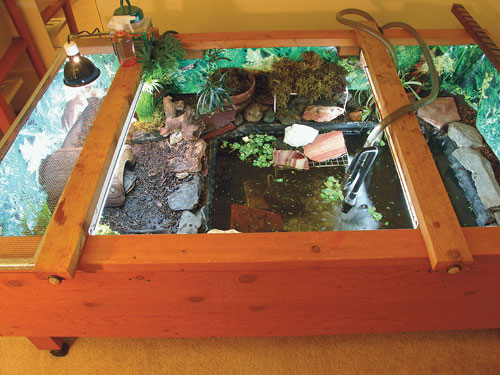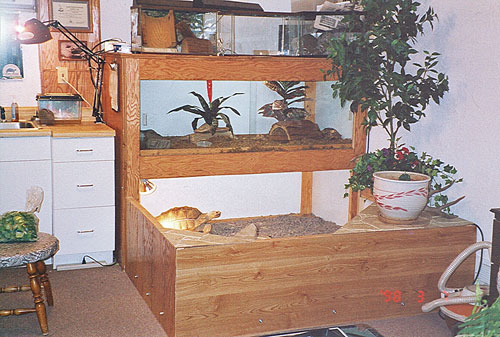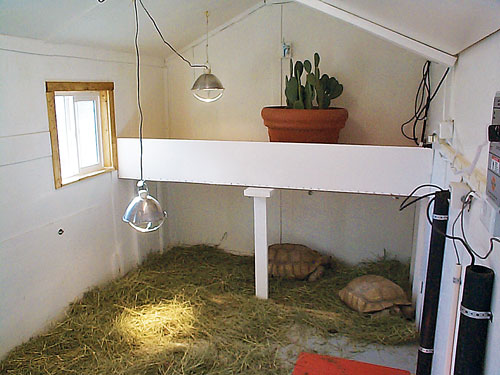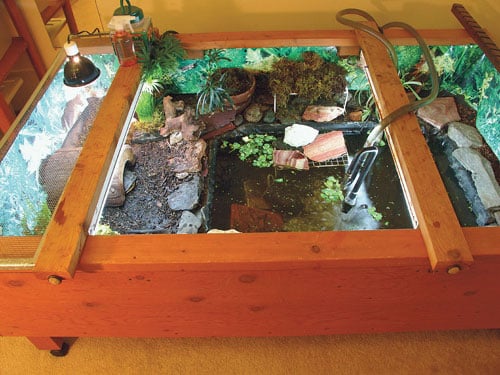Make your indoor tortoise or turtle table housing stand out.
In the 1941 movie The Maltese Falcon, Kasper Gutman explains to Sam Spade that an order of crusading knights persuaded Emperor Charles V to give them the island of Malta. The emperor made but one condition: The knights were to pay him the tribute of a falcon each year in acknowledgment that Malta was still under Spain. Their first tribute was special. “They hit upon the happy thought of sending the emperor, for the first year’s tribute, not an insignificant live bird, but a glorious golden falcon, encrusted from head to foot with the finest jewels in their coffers.”

Photo courtesy Mary Hopson
Mary Hopson's Cuora amboinensis habitat is an excellent example of a semiaquatic setup.
That’s what I hope to do here: to provide not just the basics of building turtle tables but also the extras to encourage something truly unique and spectacular. Besides covering the construction of a simple table, I’ve persuaded the World Chelonian Trust, a turtle and tortoise conservation group, to open their coffers, so to speak, and give you a glimpse of what lurks inside.
Shape of Things to Come
Tortoise and turtle tables are eminently useful pieces of equipment. They are more aesthetically pleasing than plastic tubs and easier to clean than aquariums. Stacked two (or more) high, or with a shelf or compartment below for storage, they provide a unique venue to display terrestrial and semiaquatic turtle species. There are even “table” alternatives for aquatic species, as well. If constructed large enough, turtlekeepers can locate basking areas at one end with a hide box at the other. With plantings and water features, they may become a focal point of any room.

Photo courtesy Ken Carlsen
Ken Carlsen's aesthetically pleasing enclosures are creative and use space well. .
Several factors need considerable thought before deciding on any captive enclosure. The enclosure’s size, shape, material and aesthetic appeal, and the turtle species, its current and ultimate size, and the number of inhabitants all determine the makeup of a turtle table.
When planning for table size, keep in mind floor space occupied by accouterments, such as plantings, water features and hide boxes. Materials used in habitat construction are also important, but all have good and bad characteristics. Initially, melamine resin, a type of plastic, looks good as a building material. However, unless properly sealed, the unfinished seams allow waste and excess water to seep into the pressed-wood interior. This ultimately leads to warping and loss of structural integrity. Pressure-treated wood is more durable, but the poisons that keep insects away may also harm your turtles.
Commercially available aquariums are common, but they may not be the best choice for chelonians unless turtles are very small. Another consideration is a large aquarium’s cost and features. Their height is great for fish, but turtles and tortoises don’t use it. Glass and fine-mesh tops also inhibit many types of light. For instance, both glass and plastic filter out UVB.

Photo courtesy Ken Carlsen
Having a place to bask and a place to hide is an important element within each enclosure.
Knowing both the current and ultimate size of inhabitants is critical. Otherwise, turtles may quickly outgrow the planned habitat, and the time, money and effort expended will have been in vain. Number and type of inhabitants also impact your ultimate dimensions because the enclosure should be dramatically increased for each additional animal housed. Territorial species need even more space.
Environmental requirements are extremely important. Adequate space is necessary to provide an appropriate thermal gradient, a sufficiently large water area, a hide box and a feeding area. Desert species housed in an air-conditioned home may need a top.
Semiaquatic chelonians require larger water features than terrestrial ones. Lighting must also be geared toward the turtle species, and nesting must be accounted for, as well.
Turtlekeepers often want something that looks natural, but when one adds substrates, plants, water features and hiding areas to the setup, these decorations quickly eat up space required for animals. Leave open a minimum of 40 to 50 percent of available floor space for movement, feeding and defecating. This area should also allow for an adequate temperature gradient, so turtles can thermoregulate. Placing heat and ultraviolet light sources at one end is preferred. Adequate room for hiding is also important because many species become stressed in very large enclosures.
Tailoring to the Turtle
Turtle activity levels are another consideration. Active species need far greater space than secretive ones, which require more hiding places. Greater land allowance is needed for terrestrial species, and aquatic species need more water.
Aquatic and semiaquatic turtle enclosures have both land and water requirements. Habitats should have a width five to six times the turtle’s carapace length and a depth three to four times the CL. Habitat height should be at least twice the CL to discourage escapes. Turtles often pile on top of each other, particularly in corners. This problem may also be addressed, at least in part, by providing a lid or a lip that extends over the enclosure. If chelonians are of breeding size or age, also consider a space for nesting.
The enclosure’s water feature should be large enough to provide sufficient space for the turtles to swim freely and feed. Species that burrow in the bottom of water areas should have substrate layers (sand, silt, etc.) in their water features like what is found in the land areas. Water features for turtles native to still and moving water should mimic this environment, whereas inhabitants of fast-moving streams need a power head to reproduce that setting. To promote ease of cleaning, supply two water bins, one inside the other. This prevents elaborate reseating of the water area — holding its place, so to speak. Provisions for regular draining, cleaning and disinfecting of the water area should be considered as should filtration in between maintenance. Next Page>>


